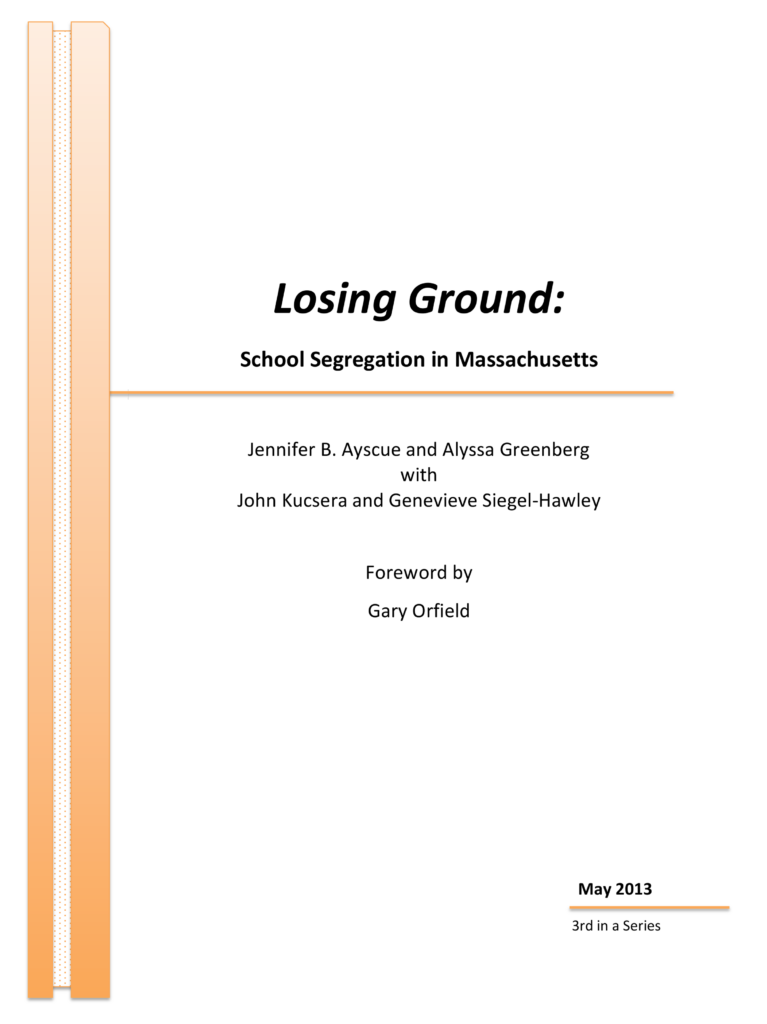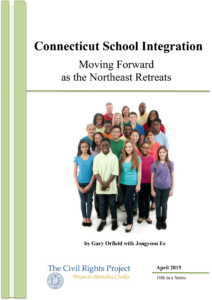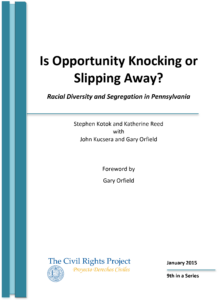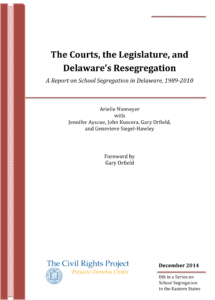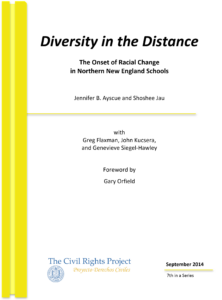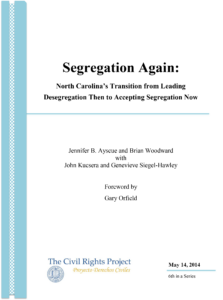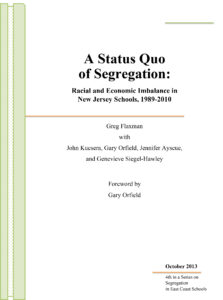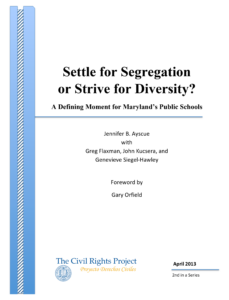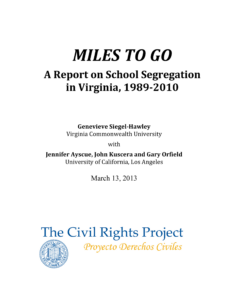Executive Summary
Though once a leader in school integration, Massachusetts has regressed over the last two decades as its students of color have experienced intensifying school segregation. In 1965 Massachusetts passed the Racial Imbalance Act, becoming an emerging leader in school integration. In 1966, the Metropolitan Council for Educational Opportunity (METCO) was established in Boston and Springfield to provide for inter-district transfers between city and suburban schools. In 1974, an amendment was signed into law that prohibited the state from enacting mandatory assignment for desegregation but that provided valuable incentives for local school districts to create voluntary school desegregation plans. In the 1980s and 1990s, 22 school districts adopted such plans. Meanwhile, choice options, such as magnet schools throughout the state, charter and pilot schools in Boston, and controlled choice in Cambridge, have had both positive and negative effects on achieving diverse schools in the state. Alongside multiple court decisions restricting the use of race in student assignment plans, districts in Massachusetts, including Boston and Cambridge, began to use other approaches, to achieve diversity in their schools during the late 1990s and early 2000s, such as socioeconomic status with a race-conscious backup factor in instances in which socioeconomic status resulted in segregation. In the late 1990s, the state’s Department of Education eliminated the Bureau of Equal Educational Opportunity, which had overseen desegregation efforts. In 2001, the state eliminated the incentives that had been previously provided to school districts that chose to adopt desegregation plans. The interdistrict transfer program METCO continues to operate in 2013, though funding is historically unstable and insufficient to meet demand for the program.
This report investigates trends in school segregation in Massachusetts over the last two decades by examining concentration, exposure, and evenness measures by both race and class. After exploring the overall enrollment patterns and segregation trends at the state level, this report turns to two main metropolitan areas within the state—Boston and Springfield—to analyze similar measures of segregation for each metropolitan area.
Major findings in the report include:
Massachusetts
- The white share of Massachusetts’s public school enrollment decreased from 81.6% in 1989-1990 to 68.5% in 2010-2011, and during the same time period the Latino share of enrollment increased by 102.7%, a substantial increase from 7.4% to 15%.
- The typical black student attends a school with 59.4% low-income students and the typical Latino student attends a school with 65.0% low-income students as compared to the typical white student who attends a school that is 23.3% low-income.
- Relatively high and increasing percentages of low-income students are enrolled in intensely segregated schools; their share of the enrollment increased from 71.1% in 1999-2000 to 84.8% in 2010-2011.
- Over the last two decades, the percentage of majority minority schools has more than doubled, intensely segregated schools have increased by more than seven times their original share, and in 2010-2011, a small share of apartheid schools existed that did not exist two decades earlier.
- In 2010-2011, a large share of Massachusetts’s black students (69.4%) and Latino students (68.5%) were enrolled in majority minority schools.
- In 2010-2011, the typical black student attended a school with 36% white students and the typical Latino attended a school with 35.6% white students despite the fact that white students made up 68.5% of the overall enrollment in the state. Conversely, the typical white student attended a school that was 80.6% white.
Metro Boston
- The white share of Boston’s public school enrollment decreased from 81.4% in 1989- 1990 to 68.3% in 2010-2011, and the Latino share of enrollment increased by 107.3%, a notable increase from 6.9% to 14.3%.
- The typical black student attends a school with 58.7% low-income students and the typical Latino student attends a school with 63.5% low-income students, which is two to three times the share of low-income students in schools attended by the typical white student (21.9%).
- Very high and increasing percentages of low-income students are enrolled in majority minority schools; in 2010-2011, majority minority schools enrolled 72.3% low-income students, intensely segregated schools enrolled 83.7% low-income students, and apartheid schools enrolled 81.3% low-income students.
- Over the last two decades, the percentage of majority minority schools has more than doubled, intensely segregated schools have more than quintupled their original share, and in 2010-2011, a small share of apartheid schools existed that did not exist two decades earlier.
- In 2010-2011, a large share of Boston’s black students (69.9%) and Latino students (67.7%) were enrolled in majority minority schools.
- In 2010-2011, even though the overall white student enrollment in Boston was 68.3%, the typical black student attended a school with 35.7% white students and the typical Latino attended a school with 36.4% white students while the typical white student attended a school that was 80.2% white.
- In 2010-2011, the average school was 31% less diverse than the entire intrastate metropolitan area of Boston, and 90% of this difference in diversity between the average public school and the entire metro area was due to segregation across district boundaries rather than within districts.
- All ten of the highest enrolling districts in the metro area that were opened in all time periods had a smaller proportion of white students enrolled in 2010-2011 than in 1989-1990, and in three of those districts the white proportion of students in 2010-2011 had dropped to half or less of what it had been two decades earlier.
- In 1989-1990, three of the ten highest enrolling districts in the metro were predominantly white; however, by 2010-2011 all three of those districts were diverse. Of the five districts that were diverse in 1989, four of them were predominantly nonwhite in 2010-2011. The other two districts, which were predominantly nonwhite in 1989-1990, remained predominantly nonwhite in 2010-2011.
Metro Springfield
- The white share of Springfield’s public school enrollment decreased from 73.8% in 1989-1990 to 62% in 2010-2011, and during the same time period the Latino share of enrollment increased from 15.4% to 25%.
- The typical white student attends a school that is 32.4% low-income while the typical black student attends a school that is 70.3% low-income, and the typical Latino student’s school is 74.4% low-income.
- Very high and increasing percentages of low-income students are enrolled in majority minority and intensely segregated schools, indicating that Springfield’s students are segregated by race and class; the share of low-income students in intensely segregated schools increased from 75.2% in 1999-2000 to 89.9% in 2010-2011.
- Over the last two decades, the share of majority minority schools has increased from 22.2% to 27.4%, and intensely segregated schools, which did not even exist in Springfield two decades ago, accounted for 9.1% of schools in 2010-2011.
- In 2010-2011, the vast majority of Springfield’s black (80.8%) and Latino students (78.3%) was enrolled in majority minority schools.
- In 2010-2011, the typical black student attended a school with 28.2% white students and the typical Latino attended a school with 28.3% white students even though white students made up 62% of the overall enrollment in the metro area. Conversely, the typical white student attended a school that was 80.2% white.
- In 2010-2011, the average school was 34% less diverse than the entire intrastate metropolitan area of Springfield, and 94% of this difference in diversity between the average public school and the entire metro area was due to segregation across district boundaries rather than within districts.
- All ten of the highest enrolling districts in the metro that were open in all time periods had a smaller share of white students enrolled in 2010-2011 than in 1989-1990.
- In 1989-1990, eight of the metro’s ten highest enrolling districts were predominantly white; however, by 2010-2011 only five of those districts remained predominantly white, and the other three were diverse. Both districts that were predominantly nonwhite in 1989-1990 remained that way in 2010-2011.
These findings highlight the deepening segregation by race and class of Massachusetts’s public school students. These trends toward increasing segregation for the last two decades will undoubtedly have lasting negative impacts both for minority communities and for the community at large. Decades of social science research indicate that segregated schools are strongly related to many forms of unequal educational opportunity and outcomes. Minority segregated schools have fewer experienced and less qualified teachers, high levels of teacher turnover, inadequate facilities and learning materials, high dropout rates, and less stable enrollments. Conversely, desegregated schools are linked to profound benefits for all students. Desegregated learning environments are related to improved academic achievement for minority students with no corresponding detrimental impact for white students, improved critical thinking skills, loftier educational and career expectations, reduction in students’ willingness to accept stereotypes, heightened ability to communicate and make friends across racial lines, and high levels of civic and communal responsibility.
This report provides multiple recommendations for those who are seeking to address resegregation in Massachusetts’s schools:
- Massachusetts needs to develop state-level policies that focus on reducing racial isolation and promoting diverse schools. Such policies should address how districts can create student assignment policies that foster diverse schools, discuss how to recruit a diverse teaching staff, provide a framework for developing and supporting inter-district programs, and require that districts report to the state on diversity-related matters for both public and charter schools.
- State and local officials should work to promote diversity in charter school enrollments and consider pursuing litigation against charter schools that are receiving public funds but are intentionally segregated, serving only one racial or ethnic group, or refusing service to English language learners.
- Fair housing agencies and state and local housing officials need to regularly audit discrimination in housing markets and ensure that potential home buyers are not being steered away from areas with diverse schools.
- Local fair housing organizations should monitor land use and zoning decisions and advocate for low-income housing to be set aside in new communities that are attached to strong schools.
- Housing officials need to strengthen and enforce site selection policies so that they support integrated schools.
- Schools—both public and charter—should not be built or opened in racially isolated areas of the district.
- Local educational organizations and neighborhood associations should vigorously promote diverse communities and schools as highly desirable places to live and learn.
- Efforts should be made to foster the development of suburban coalitions to influence state-level policy-making around issues of school diversity and equity.
- Districts should develop policies that consider race among other factors in creating diverse schools.
- Magnet schools and transfer programs within district borders should also be used to promote more racially integrated schools. The state should build on the programs which are already in place and achieving success, such as METCO. Funding for METCO should be increased so that the program can expand by increasing the number of suburban districts that enroll METCO students.
- Local organizations and parents should ask the school board to address and correct noncompliance and violations of long-standing desegregation plans.
- Interested citizens and elected officials should support judicial appointees who understand and seem willing to address the history of segregation and minority inequality and appear ready to listen with open minds to sensitive racial issues that are brought into their court rooms.
It is necessary that Massachusetts now take steps to reverse these trends by being proactive in addressing the segregated nature of its public schools. The state’s students of color are already experiencing high levels of segregation. Given the trends presented in this report, it is likely that segregation will only continue to intensify if nothing is done to address it.
This report is part of a special series, “School Segregation Trends in the Eastern States.” These studies explore trends in enrollment and school segregation patterns from 1989 to 2010 at the state and regional levels, including various metro areas for each state. The reports also document the history of school desegregation in each state and across its geographic regions, including key desegregation cases and remedies, when applicable.
In compliance with the UC Open Access Policy, this report has been made available on eScholarship:
